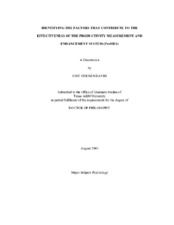| dc.description.abstract | The Productivity Measurement and Enhancement System (ProMES) is a human resource intervention that provides feedback to members of an organizational unit via a measurement system constructed by the unit personnel. The unit constructs the system by defining their objectives, identifying productivity indicators for each objective, and developing utility curves or contingencies for each indicator, specifying the overall and relative value to the organization of different performance levels on each indicator. Over the years, it has produced very positive results upon implementation. However, there has been great variability in the effectiveness of ProMES. This study attempted to identify the factors that contributed to this variability. Three major factors were proposed to influence the success of the intervention: feedback quality, the degree to which units prioritized their actions on the feedback, and the organizational social context. Additionally, the individual effects of the components of the organizational social context factor were analyzed; these components included the degree of employee participation in the intervention, unit attitudes towards productivity improvement, organizational support for the intervention, and organizational stability. Three productivity indices were used as dependent variables: the unit d-score (the difference between feedback productivity and baseline productivity divided by the pooled standard deviation), the rate of productivity change over the first third of the feedback stage, and the degree to which units were able to sustain prior productivity improvements over the last two thirds of the feedback stage. The degree of match with the original ProMES methodology was proposed as a moderator in the relationship between the three major factors and the criteria, and the degree of feedback interpretation training given to the unit was proposed as a moderator between the units? action on feedback and the criteria. Drawing on a database of 74 units from different industries and countries, scales were constructed to operationalize the factors. Results from multiple regression analyses indicated that favorable attitudes towards productivity improvement were associated with faster productivity improvements. Additionally, feedback quality and the action taken on feedback significantly predicted greater and faster productivity improvements. The implications for human resource professionals and researchers in industrial/organizational psychology are discussed. | en |


